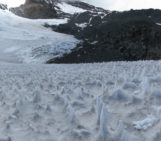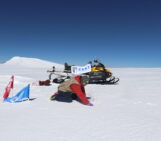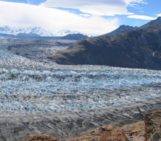
Figure 1: The GIF above shows the extent of the Patagonian Ice Sheet in 5000-year time slices. The colours around the margin show where scientists have high, medium and low confidence in where they have placed the margin. Reproduced with permission from Bethan Davies, www.AntarcticGlaciers.org.
Today’s Patagonian ice caps are confined to the high-altitude Andean Mountain range as the Northern and Southern Patagonia ice fields, and they are rapidly melting. The southern part of the Patagonian ice cap drains partially through fast-flowing ice streams into the fjords of Patagonia. Glaciers in this region have been losing ice at accelerating rates by large calving events, due to rising global mean temperatures (see this post). The changes are enormous and have been calculated to contribute 0.048 mm annually to global sea-level rise.
A fluctuating ice sheet
This is not the first time the Patagonian ice sheet has experienced large-scale iceberg calving events. Thanks to glacial depositional and erosional landforms (like moraines and large-scale lineaments) left as imprints of the old ice-sheet extent, we know that it stretched over 2000 km from 38 to 55°S. At its maximum extent (33 to 28 thousand years ago), colder temperatures and shifted moisture-bearing winds facilitated a larger ice sheet, flowing into the south-east Pacific Ocean to the west and reaching the Argentinian lowlands to the east.
Because of the ice sheet’s large extent, it is highly sensitive to fluctuations of a belt of winds called the Southern Westerlies (see this post). Changes in the ice sheet can therefore tell us about how these winds have changed in the past and their role in the global climate.

Figure 2: Representative photo of the high-resolution sediments from marine core Site 1233. A and B show examples of Ice Rafted Debris seen through a microscope. Core photo modified from Shipboard Scientific Party, 2003. Ice rafted debris photo taken at FARlab, University of Bergen (Credit: Thale Damm-Johnsen).
What story can marine sediment cores tell?
How can we get a clear picture of how the ice-sheet extent has varied through time? Luckily, the ocean floor is the perfect place to look for traces of past climate. The International Ocean Discovery Program (IODP) has set out to reveal past climate change from a marine perspective. By retrieving sediment cores that contain biological (such as foraminifera, diatoms, …) and lithological (for example varves and minerals) clues of past climate, climate scientists have pieced together a picture of a glacial climate system that fluctuated on millennial timescales. ODP Site 1233 is one of these sediment cores which is ideally located to provide a record of these changes that affected the northern part of the Patagonian ice sheet (See Figure 1).
Deposits from drifting icebergs
Our study at University of Bergen revealed the first record of past calving intensity from the northern part of the Patagonian ice sheet. We did this by counting sediment deposited by northward-drifting icebergs, known as ice rafted debris (See Figure 2). We focused in particular on a warm climate event called the Antarctic Warming event 1 (A1) (which took place 39.9-36.6 thousand years ago). Previous studies from our core site show that the near-surface ocean here warmed at the same time as warming over the Antarctic ice sheet, recorded in ice cores (see this post or this post). It is thought the Patagonian ice sheet lagged the sea surface temperature changes by 500-600 years, suggesting a marine control over the ice sheet extent.
A dynamic ice sheet edge?
The high resolution (<36 years) ice rafted debris record shows that the calving intensity of the north-western Patagonian ice sheet was highly variable on multi-decadal timescales during this A1 warming event. Our study might indicate that the ice-sheet edge reacted rapidly to changes occurring in the ocean and atmosphere during this warm event.
How could this behaviour be preserved in the marine sediment record? The calved icebergs would be steered by the prevailing wind and ocean current and drift towards our study site, 38 km offshore (See Figure 3). It is also important to keep in mind the controlling factors related to the rates of ice rafted debris deposition. During peak A1, temperatures were likely too high (maximum 12.5°C) in the sub-surface ocean for many icebergs to survive and reach our core site. The ice sheet could also have retreated on to land in some areas, so would have calved less into the ocean.

Figure 3: The concept of depositing and preserving ice rafted debris in marine sediments. Modified from JAMSTEC (2014).
Our findings show the potential for using ice-rafted debris from high-resolution marine sediment records as a method of reconstructing how the western margin of the Patagonian ice sheet fluctuated in the past. Applying these methods in other locations along of the coast of Chile might uncover how the marine-terminating edge of the large ice sheet fluctuated in response to past climate change. As we use the past as a key to the present, several reconstructions of the western margin of the Patagonian ice sheet could yield crucial insight into how the region, and how the remaining two ice caps, will react to further large scale climate change.
Further reading
- Although parts of the former extent of the Patagonia Ice Sheet is still uncertain, recent work has been carried out to give a coherent picture of its extent over the last 35,000 years. You can explore this together with the clues geologists use to interpret past ice-sheet presence here, in the interactive map from PATICE and know more in the study related to it.
- Did you know… the Andes are so cryo-diverse?
- Boex, J., Fogwill, C., Harrison, S., Glasser, N., Hein, A., Schnabel, C., & Xu, S. (2013). Rapid thinning of the late Pleistocene Patagonian ice sheet followed migration of the southern westerlies. Scientific Reports, 3, 2118.
- Garcia, J.-L., Hein, A. S., Binnie, S. A., Gomez, G. A., Gonzalez, M. A., & Dunai, T. J. (2018). The mis3 maximum of the torres del paine and ultima esperanza ice lobes in Patagonia and the pacing of southern mountain glaciation. Quaternary Science Reviews, 185, 9-26.
- Jaber, W. A., Rott, H., Floricioiu, D., Wuite, J., & Miranda, N. (2019). Heterogeneous spatial and temporal pattern of surface elevation change and mass balance of the patagonian ice fields between 2000 and 2016. The Cryosphere, 13 (9), 2511-2535.
- Kaiser, J., Lamy, F., Arz, H. W., & Hebbeln, D. (2007). Dynamics of the millennial-scale sea surface temperature and Patagonian ice sheet fluctuations in southern Chile during the last 70 kyr (odp site 1233). Quaternary International, 161 (1), 77-89.
- Lamy, F., Kaiser, J., Ninnemann, U., Hebbeln, D., Arz, H. W., & Stoner, J. (2004). Antarctic timing of surface water changes off Chile and Patagonian ice sheet response. Science, 304 (5679), 1959-1962.
- Moreno, P. I., Denton, G. H., Moreno, H., Lowell, T. V., Putnam, A. E., & Kaplan, M. R. (2015). Radiocarbon chronology of the last glacial maximum and its termination in northwestern Patagonia. Quaternary Science Reviews, 122, 233-249.
- Mix, A.C., Tiedemann, R., Blum, P., et al., Proc. ODP, Init. Repts., 202: College Station, TX (Ocean Drilling Program), 1-76. doi:10.2973/odp.proc.ir.202.104.2003.
Edited by Jenny Arthur
 Thale Damm-Johnsen is Ph.D student in Department of Geography at Durham University, with focus on reconstructing past summer sea-ice in the Weddell sea by using stomach oil deposits from snow petrels. The study described in the blogpost is related to her master thesis at University of Bergen, supervised by Kikki Kleiven, Nil Irvali and Ulysses Ninnemann.
Thale Damm-Johnsen is Ph.D student in Department of Geography at Durham University, with focus on reconstructing past summer sea-ice in the Weddell sea by using stomach oil deposits from snow petrels. The study described in the blogpost is related to her master thesis at University of Bergen, supervised by Kikki Kleiven, Nil Irvali and Ulysses Ninnemann.




